Situation of Japan birds observed from the studies
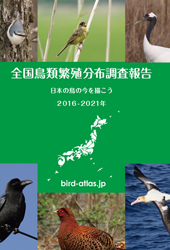 |
Ueta M & Uemura S (2021) Report of the Breeding Bird Atlas of Japan -Mapping the present status of Japan’s birds 2016-2021. The Japan Breeding Bird Atlas Group, Fuchu, Japan. English editing: Reiko Kurosawa and Simba Chan |
The third survey of the Japan Breeding Bird Atlas program, which was started
in the 1970s (first: 1974-1978) and subsequently in the 1990s (second:
1997-2002), was conducted from 2016 to 2021. 2,344 sites across Japan were
surveyed with the support of 2,106 survey participants. In addition, 243,080
questionnaires were received from all over Japan. As a result, 379 species
were recorded (21 of which were non-native species, introduced intentionally
or unintentionally), and 278 species (plus 3 subspecies) with breeding
records (or possible breeding records) in Japan, including past records,
were mapped and compiled.
Dominant Bird Species in Japan
The species with the highest number of recorded meshes was Japanese Bush
Warbler, as in the first (1970s) and the second (1990s) surveys. In the
third survey in the 2010s, Large-billed Crow and Brown-eared Bulbul followed
along. In Hokkaido, in contrast to the rest of Japan, Black-faced Bunting
was the most common species.
The change in the number of recorded meshes over time since the 1970s shows that Meadow Bunting, which ranked second in the first survey (1970s), has dropped in rank. Five species of open habitat (Meadow Bunting, Carrion Crow, Eurasian Tree Sparrow, Grey-capped Greenfinch, and Bull-headed Shrike) were ranked in the top ten recorded in meshes in the 1970s decreased to four in the 1990s and further decreased to three in the 2010s. The abundance of forest species, on the other hand, increased.
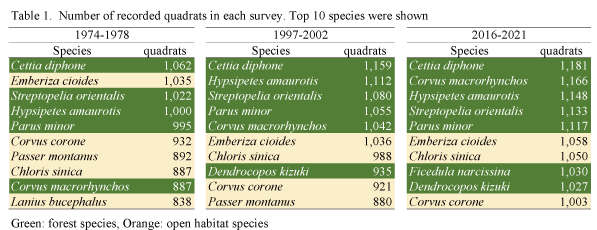
The most numerous bird species recorded in the 2010s survey was Brown-eared
Bulbul, followed by Japanese Bush Warbler and Eurasian Tree Sparrow. Surveys
in the 1990s and 2010s showed a decreasing trend in the abundance of open
habitat species, such as Eurasian Tree Sparrow, Barn Swallow, and White-cheeked
Starling, as well as in the number of recorded meshes.
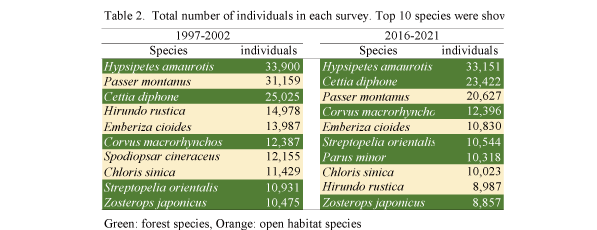
Species that have Increased
Based on the results of 1,947 comparable field survey sites, we summarized
the results of the second (1990s) and the third (2010s) surveys in terms
of changes in the number of recorded sites and the total abundance of individual
birds. Many forest bird species, including non-native birds such as Chinese
Hwamei and Red-billed Leiothrix, increased in abundance. Also, many species
of summer migrants which had been concerned as declining and Large fish-eating
birds such as Great Cormorant also increased.
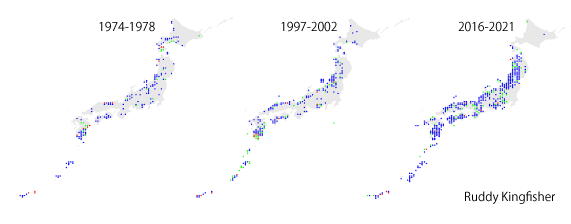
Species that have Decreased
On the other hand, the number of recorded sites decreased for small fish-eating
birds such as Little Tern and Little Egret. The total recorded numbers
decreased for aerial feeders such as White-throated Needletail, Pacific
Swift, and Barn Swallow, and for open habitat (including farmland) species
such as Eastern Cattle Egret, Barn Swallow, White-cheeked Starling, and
Eurasian Tree Sparrow.
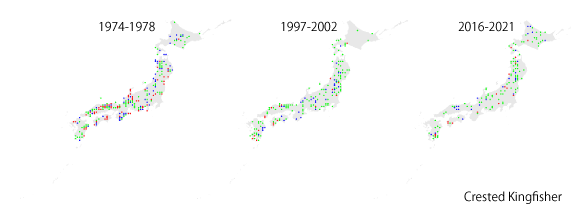
Climate Change and Breeding Distribution
Some of the changes in distribution during the breeding season could be
attributed to the effects of the global climate change. For example, the
breeding distribution of Black-faced Bunting was considered to be gradually
moving northward. In Japan, it breeds mainly in northern Japan and at high
altitudes in the central and western parts of the country. On the other
hand, in Russia, this species is increasing its distribution toward the
north, and its population is increasing. In addition, the distribution
of Olive-backed Pipit was shrinking in western Japan and the lower elevation
parts of the country.
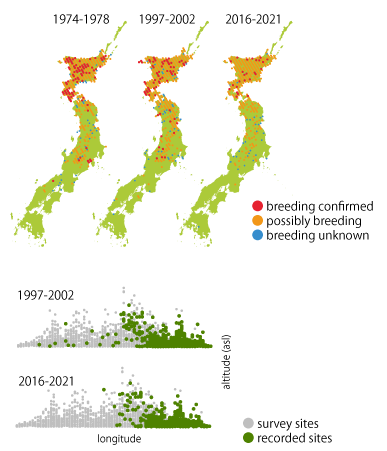
Changes in the horizontal (top) and vertical (bottom) distributions of Black-faced Bunting. Records west of central Honshu were decreasing.

